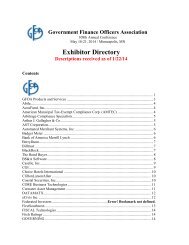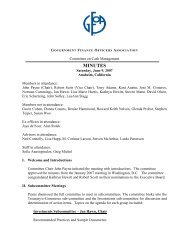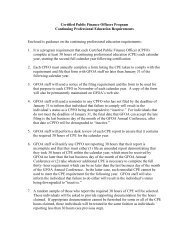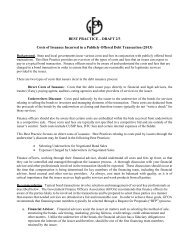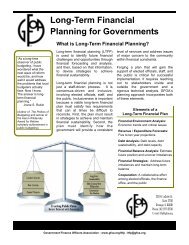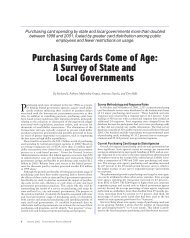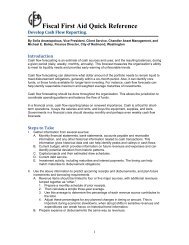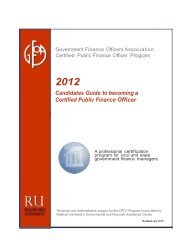Editor's note - Government Finance Officers Association
Editor's note - Government Finance Officers Association
Editor's note - Government Finance Officers Association
Create successful ePaper yourself
Turn your PDF publications into a flip-book with our unique Google optimized e-Paper software.
Editor’s <strong>note</strong>: This article is adapted from a new GFOA publication,<br />
Cost Analysis and Activity-Based Costing for <strong>Government</strong>.<br />
In this period of tight budgets, many governments are under<br />
increasing pressure to do more with less. One potential way to<br />
reduce costs is to outsource services to private firms, non-profit<br />
organizations, or other governments that can provide the services<br />
more efficiently. In some cases, outsourcing can result in significant<br />
cost savings over the long run. In other cases, however, outsourcing<br />
may actually end up increasing a government’s total costs. How can<br />
a government know whether outsourcing a given service will result<br />
in a cost savings or a cost increase? This article answers this question<br />
by demonstrating how to perform a cost analysis.<br />
The decision as to whether to perform a service “in house” or<br />
outsource it to an external provider is commonly referred to as the<br />
“make-versus-buy” decision. This article walks through the steps<br />
involved in a make-versus-buy cost analysis. But first, two key<br />
points warrant emphasis: (1) a make-versus-buy cost analysis<br />
should use a differential cost perspective and (2) the analysis<br />
should cover a multi-year period and discount future cash flows to<br />
their present value.<br />
USE A DIFFERENTIAL COST PERSPECTIVE<br />
Differential cost is the key cost concept for evaluating the outsourcing<br />
of a service. The differential cost shows how a decision to<br />
outsource will change a government's costs. It is crucial to look at<br />
the differential costs instead of merely comparing the total costs of<br />
the status quo to the total costs of using a private contractor. The<br />
pitfall of comparing total costs is that they may include fixed costs<br />
that cannot be avoided by outsourcing a service. This could give<br />
the appearance that a government will incur fewer costs by using<br />
a private contractor when it actually will incur more. 1<br />
For example, let’s say that a private waste hauler offers to provide<br />
waste collection services to the City of Unionsville for<br />
$550,000 per year. As it stands, the total cost of providing waste<br />
collection services is $750,000 per year. Thus, it appears that the<br />
city could save $200,000 per year by hiring the private hauler.<br />
However, a closer look at the city's fixed costs reveals that it is<br />
committed to spending much of the $750,000 whether or not it<br />
switches to a private hauler. More than half of this amount is personnel<br />
costs, which the city cannot avoid because of a “no-layoff”<br />
policy and the fact that the truck drivers perform other responsibilities.<br />
Likewise, the city is committed to $50,000 per year in debt<br />
service payments for the facilities used to store and maintain its<br />
garbage trucks.<br />
Sunk costs. A potential mistake in a make-versus-buy cost analysis<br />
is the inclusion of sunk costs. A sunk cost is a cost that has already<br />
occurred and will remain the same regardless of what decision is<br />
made. As such, sunk costs should be ignored in a cost analysis.<br />
To see how including sunk costs can lead to bad decisions,<br />
suppose a county government is considering outsourcing its<br />
warehouse function to private suppliers that can maintain inventories<br />
of all the county's supplies and ship them overnight. One<br />
year earlier, the county had spent $500,000 for a consultant to<br />
develop a state-of-the-art inventory process. Opponents of the<br />
outsourcing plan argue that the county should not outsource the<br />
warehouse function because it just poured $500,000 into perfecting<br />
the existing system. However, this $500,000 should not influence<br />
the decision because it cannot be recovered regardless of<br />
the course of action the county takes; only the differential cost of<br />
the two alternatives should influence the decision. If the differential<br />
cost of outsourcing the warehouse function is $340,000 less<br />
per year than retaining this function in-house, including the sunk<br />
cost of the consulting services would lead the county to spend<br />
$340,000 per year more than it has to.<br />
Opportunity costs. Another important cost concept in makeversus-buy<br />
decisions is opportunity cost. Opportunity cost is the<br />
lost opportunity of using an asset or resource in a way other than<br />
the chosen alternative. For example, if a suburban government<br />
sells a public swimming pool to a private company to own and<br />
operate, the opportunity cost would include the admittance fee<br />
revenue that would have been collected if the pool remained a<br />
public asset. Likewise, the opportunity cost of not selling the pool<br />
would be the revenue from the sale of the pool.<br />
COVER A MULTI-YEAR PERIOD AND DISCOUNT<br />
FUTURE CASH FLOWS<br />
A cost comparison should cover a multi-year period. This is<br />
important for two reasons. First, a multi-year analysis is more<br />
likely to reveal whether outsourcing will generate long-term savings.<br />
A government should experience much of the cost savings<br />
related to outsourcing in later years, as leases and contracts<br />
expire and fixed costs become variable costs. Second, a multiyear<br />
contract is usually more attractive to potential vendors,<br />
which creates more competition and drives down the costs of<br />
the contract.<br />
In a multi-year analysis, future cash flows should be discounted<br />
to their present value. This ensures that appropriate weight is given<br />
to future costs and benefits. Discounting is the process of converting<br />
a future value into its present value. 2<br />
16 <strong>Government</strong> <strong>Finance</strong> Review | August 2004
HOW TO PERFORM A MAKE-VERSUS-BUY<br />
COST ANALYSIS<br />
A make-versus-buy cost analysis involves four basic steps:<br />
■ Step 1: Define the service<br />
■ Step 2: Calculate the in-house costs that could be avoided<br />
by outsourcing the service<br />
■ Step 3: Calculate the total costs of outsourcing<br />
■ Step 4: Compare the cost savings from outsourcing<br />
to the costs incurred<br />
Exhibit 1 illustrates the steps in a make-versus-buy cost analysis.<br />
To simplify the diagram, the analysis is limited to a single<br />
year. In actual practice, the analysis should cover a three- to fiveyear<br />
period, and steps 2b through 4 should be repeated for each<br />
year. The totals for each year should be discounted to their<br />
present value.<br />
Step 1: Define the service. The first step in a make-versusbuy<br />
cost analysis is to clearly define the government service that is<br />
being considered for outsourcing. In other words, specify the quality<br />
and quantity of the service and the output and outcomes that<br />
are expected. This is necessary so that there is an apples-to-apples<br />
comparison between the service the government is already providing<br />
and the service proposed by outside contractors. If a service<br />
is vaguely or incorrectly defined, the in-house costs may be<br />
higher (or lower) than the contract costs simply because the government<br />
is providing more (or less) service than what is documented<br />
in the request for proposals.<br />
When specifying the quality and quantity of the service, it is<br />
important to investigate whether government employees informally<br />
provide additional services to residents. For example, a parks and<br />
recreation department may perform tree trimming for elderly residents<br />
upon request, or may deliver wood chips free of charge.<br />
Exhibit 1: Make-Versus-Buy Cost Analysis<br />
1<br />
Define the service<br />
2a<br />
Determine the costs<br />
of performing the<br />
service in-house<br />
2b<br />
Costs of In-House Service<br />
Determine the in-house costs<br />
that the government could avoid<br />
by outsourcing<br />
Cost Items Costs Costs that<br />
Could be<br />
Avoided<br />
Direct Costs<br />
Salaries & wages $X<br />
Pension & benefits $X<br />
Supplies $X $X<br />
Materials $X $X<br />
Travel $X $X<br />
Printing $X $X<br />
Rent $X<br />
Utilities $X $X<br />
Communications $X $X<br />
Interest costs $X<br />
Facility & equipment costs $X<br />
Indirect Costs<br />
General administration $X<br />
Internal services $X<br />
Department administration $X<br />
Total $X $X<br />
3a<br />
3b<br />
3c<br />
3d<br />
3e<br />
4<br />
Bid from<br />
alternative<br />
provider<br />
<strong>Government</strong>’s<br />
contract<br />
administration<br />
costs<br />
<strong>Government</strong>’s<br />
transition costs<br />
Net resale or salvage<br />
value of unused<br />
government assets<br />
Additional tax<br />
revenues<br />
Compare the cost savings from<br />
outsourcing to the costs incurred<br />
Costs of Outsourcing<br />
Cost Items<br />
Cost<br />
Bid Price $X<br />
Contract Administration Costs $X<br />
Transition Costs<br />
Unemployment compensation $X<br />
Accrued vacation benefits $X<br />
Severance pay $X<br />
Conversion or disposal of government $X<br />
property and equipment<br />
Penalty fees for early lease termination $X<br />
Revenues from unused<br />
governmental assets<br />
Subtotal (Costs) $X<br />
$X<br />
Additional tax revenues $X<br />
Subtotal (Revenues) $X<br />
Total (Costs – Revenues) $X<br />
Total costs<br />
of outsourcing<br />
In-house costs that could<br />
be avoided by outsourcing<br />
August 2004 | <strong>Government</strong> <strong>Finance</strong> Review 17
It is also important to examine whether the resources (labor,<br />
facilities, equipment, and material) used for the service are formally<br />
or informally shared with other government services. For<br />
example, garbage collection crews might assist with snow<br />
removal after a heavy snowfall, or they may help the parks and<br />
recreation department clean up after a summer festival. All of<br />
these details must be documented in the contract to arrive at an<br />
accurate cost comparison and to avoid disputes with vendors after<br />
the contract is signed.<br />
Step 2: Calculate the in-house costs that would be<br />
avoided by outsourcing the service. The second step is to calculate<br />
the total government costs that would be avoided or saved<br />
by outsourcing the service. To determine the costs that would be<br />
saved, first itemize the full cost of the service, including all of the<br />
direct and indirect costs. 3 Then, use this list of costs as the basis<br />
from which to determine the specific costs that would be saved if<br />
the service were outsourced. GFOA’s recommended practice on<br />
measuring the cost of government services defines the in-house<br />
costs saved by outsourcing as those costs that are either eliminated<br />
immediately or eliminated after a brief transition period. 4 It is<br />
important to remember that many fixed costs — overhead costs in<br />
particular — will remain the same even though the resources<br />
behind those costs are not being used.<br />
Cost estimates should be made on a multi-year basis and discounted<br />
to a present value. To ensure that inflation is treated consistently,<br />
nominal costs should be used if a nominal discount rate is<br />
used, and real costs should be used if a real discount rate is used. 5<br />
Step 3: Calculate the total costs of outsourcing. The third<br />
step is to calculate the total costs of outsourcing the service. The<br />
costs of outsourcing include the contractor’s bid price, the government’s<br />
contract administration costs, and the government’s transition<br />
costs, less any new revenue generated from outsourcing. These<br />
cost estimates should be discounted to their present value and<br />
cover the same period as the cost savings in the previous step.<br />
To be consistent throughout the analysis, only new costs should<br />
be counted, not the costs that would be incurred regardless of<br />
who provides the service. For example, if a government already<br />
employs workers to perform contract administration, these costs<br />
should not be included in the analysis as long as they are<br />
absorbed by existing employees.<br />
Contract administration costs. The government’s contract<br />
administration costs include all of the tasks necessary to select and<br />
manage a vendor over the life of the contract. These tasks may<br />
include reviewing and evaluating RFPs, writing and negotiating the<br />
contract, processing change orders and amendments to the contract,<br />
monitoring and evaluating vendor performance, dealing with<br />
disputes, and processing payments to the vendor. Depending on<br />
the type of contract and their own internal processes, state and<br />
local governments can estimate contract costs anywhere from<br />
0 percent to 25 percent. Some governments base their estimates of<br />
contract administration costs on a standard formula like the one<br />
in Exhibit 2 used by the U.S. Office of Management and Budget.<br />
Exhibit 2: OMB Staffing Formula for Estimating<br />
the Cost of <strong>Government</strong> Contract Administration<br />
Number of <strong>Government</strong><br />
Employees Used to<br />
Provide Service<br />
Number of Staff<br />
Needed for Contract<br />
Administration (FTEs)<br />
10 or less 0.5<br />
11 – 20 1<br />
21 – 50 2<br />
51 – 75 3<br />
76 – 100 4<br />
101 – 120 5<br />
121 – 150 6<br />
151 – 200 7<br />
201 – 250 8<br />
251 – 300 9<br />
301 – 350 10<br />
351 – 450 11<br />
2.5% of the number<br />
More than 450<br />
of government employees<br />
used to provide service<br />
Transition costs. Transition costs include all of the costs<br />
incurred by a government as it shifts a service to an outside contractor.<br />
These transition costs may include the various personnelrelated<br />
costs related to laying off employees, including unemployment<br />
compensation, accrued vacation benefits, and severance<br />
pay. 6 They may also include the preparation of government<br />
facilities and equipment for use by an outside contractor.<br />
Alternatively, these assets might be sold or otherwise disposed<br />
of, resulting in a positive or negative net salvage value. If the<br />
assets are rented, an early termination of the lease may create<br />
additional costs.<br />
Revenues from outsourcing. Any additional revenues that a<br />
government collects as a result of outsourcing should be subtracted<br />
from the costs of outsourcing. In some cases, a decision<br />
to outsource a service may result in increased tax and fee revenues<br />
from the contractor. For example, a contractor may pay<br />
property taxes on a new facility constructed within city limits.<br />
18 <strong>Government</strong> <strong>Finance</strong> Review | August 2004
Another source of revenue is the sale of government assets that<br />
are no longer needed because a vendor uses its own assets to<br />
provide the service. For instance, a government might sell its<br />
garbage trucks if a vendor uses its own vehicles. Care should be<br />
taken to include only the additional revenues that are the result<br />
of outsourcing.<br />
Step 4: Compare the cost savings from outsourcing to<br />
the costs incurred. The final step in a make-versus-buy cost<br />
analysis is to calculate the difference between the costs saved by<br />
outsourcing a service and the costs incurred. If the costs saved are<br />
significantly greater than the costs incurred, then outsourcing may<br />
make financial sense.<br />
The final result of a cost analysis is often based on assumptions<br />
that have a fair degree of uncertainty. As a countermeasure, it is<br />
prudent to conduct a sensitivity analysis, which tests the sensitivity<br />
of the final result to changes in the underlying assumptions. There<br />
are three main methods for performing a sensitivity analysis. One<br />
method is to recalculate the result under pessimistic, expected,<br />
and optimistic scenarios. A second method is to recalculate the<br />
result many times by testing each assumption over a wide range of<br />
values. A third method is to calculate a probability distribution for<br />
the result of an analysis. 7 To address the uncertainty inherent in any<br />
cost analysis, governments sometimes require that the cost savings<br />
from outsourcing exceed the cost of providing the service in-house<br />
by a certain margin. For example, the State of Texas and the federal<br />
government use a 10 percent threshold.<br />
There are many nonfinancial costs and benefits that are difficult<br />
to quantify in this type of analysis but that should be considered<br />
nonetheless. For example, there may be a significant difference in<br />
the quality of the service provided by a government and the quality<br />
of the service provided by a private contractor. Underutilized facilities,<br />
labor, and equipment during the transition period may also<br />
entail opportunity costs to the government. And outsourcing may<br />
reduce a government's ability to use the service to carry out policy<br />
goals. On the positive side, shifting a service to a contractor also<br />
transfers liability and other risks to the contractor (even though<br />
these risks are likely built into the contract price). <strong>Government</strong>s are<br />
developing increasingly sophisticated ways of handling these<br />
issues, such as requiring providers to return a percentage of their<br />
profits to non-profit organizations in the community.<br />
A CASE STUDY<br />
An example will further illustrate how to perform a cost analysis<br />
for a make-versus-buy decision. Suppose the City of Greenville<br />
is considering outsourcing lawn and grounds maintenance to a<br />
private firm. As a first step toward determining if outsourcing lawn<br />
and grounds maintenance makes financial sense, the city defines<br />
this particular service. Lawn and grounds service is provided by<br />
the city’s Public Works Department, which maintains 200 acres of<br />
developed parkland. Exhibit 3 specifies the activities that comprise<br />
the lawn and grounds maintenance function.<br />
Exhibit 3: Current Lawn and Grounds<br />
Maintenance Service<br />
Services Provided<br />
by Public Works<br />
Grass mowing<br />
and trimming<br />
Tree and bush trimming<br />
Litter collection<br />
Grass fertilization<br />
Schedule<br />
March – May (every 7 days)<br />
June – September (every 14 days)<br />
Once per year (in fall)<br />
Every two weeks<br />
Once per year (in spring)<br />
Next, the city calculates the total costs that would be avoided or<br />
saved by outsourcing lawn and grounds maintenance. To determine<br />
the costs that would be saved by outsourcing, the full cost of<br />
the service is itemized, including all of the direct and indirect<br />
costs. The top portion of Exhibit 4 shows how this would look over<br />
a five-year period. The city would be able to avoid several of the<br />
costs in the second column if the service were outsourced. About<br />
$400,000 in personnel costs would be avoided by virtue of a combination<br />
of layoffs of seasonal employees and a promise from the<br />
vendor to hire 30 percent of the city’s employees. The remaining<br />
employees would be reassigned to other tasks. The city would<br />
continue to incur insurance costs for lawn maintenance equipment<br />
until the insurance contract terminates after the first year.<br />
Administrative overhead costs often cannot be avoided (at least in<br />
the short run) because they are generated in other departments,<br />
such as finance and human resources, that would likely remain<br />
fully staffed even if the service were outsourced. The total savings<br />
for each year are discounted to their present value. 8<br />
The third step is to calculate the total costs of outsourcing lawn<br />
and grounds maintenance. The bottom portion of Exhibit 4<br />
shows how this would look over a five-year period. The costs of<br />
outsourcing include the contractor’s bid, the government’s contract<br />
administration costs, and the government’s transition costs,<br />
less the additional revenue generated from outsourcing. The<br />
total costs for each year are discounted to their present value.<br />
Only the new costs associated with outsourcing the service are<br />
included in the analysis.<br />
August 2004 | <strong>Government</strong> <strong>Finance</strong> Review 19
Exhibit 4: Illustrative Make-Versus-Buy Analysis<br />
The Costs of Performing the Service In-House<br />
Cost Items<br />
Current<br />
Annual Costs<br />
of Service<br />
In-House Costs that Could be Avoided by Outsourcing<br />
Now Year 1 Year 2 Year 3 Year 3 Year 4<br />
Personnel $600 ,000 $400 ,000 $400 ,000 $400 ,000 $400 ,000 $400 ,000 $400 ,000<br />
Insurance $16,000 $0 $16,000 $16,000 $16,000 $16,000 $16,000<br />
Equipment & Supplies $134 ,000 $134 ,000 $134 ,000 $134 ,000 $134 ,000 $134 ,000 $134 ,000<br />
Fuel $150 ,000 $150 ,000 $150 ,000 $150 ,000 $150 ,000 $150 ,000 $150 ,000<br />
Administrative Overhead $100 ,000 $0 $0 $0 $0 $0 $0<br />
TOTAL $1,000,0 00 $684 ,000 $700 ,000 $700 ,000 $700 ,000 $700 ,000 $700 ,000<br />
A<br />
In-house costs that<br />
could be avoided<br />
by outsourcing<br />
(Net Present Value)<br />
$4,031,851<br />
=<br />
+ +<br />
(1+r) 1<br />
(1+r) 2<br />
+ + (1+r) 3<br />
(1+r) 4<br />
+<br />
(1+r) 5<br />
The Costs of Outsourcing the Service<br />
Now Year 1 Year 2 Year 3 Year 3 Year 4<br />
Bid Price $500 ,000 $500 ,000 $500 ,000 $500 ,000 $500 ,000 $500 ,000<br />
Contract Administration $75,000 $75,000 $75,000 $75,000 $75,000 $75,000<br />
Transition Costs<br />
• Unemployment compensation $0 $1,000 $1,000 $1,000 $1,000 $1,000<br />
• Accrued vacation benefits $20,000 $0 $0 $0 $0 $0<br />
• Severance pay $10,000 $0 $0 $0 $0 $0<br />
• Conversion or disposal of government<br />
property and equipment<br />
$10,000 $0 $0 $0 $0 $0<br />
• Penalty fees for early lease termination $30,000 $0 $0 $0 $0 $0<br />
Subtotal (Costs) $645 ,000 $576 ,000 $576 ,000 $576 ,000 $576 ,000 $576 ,000<br />
Revenues from sales of unused<br />
government assets<br />
$400,000 $0 $0 $0 $0 $0<br />
Additional tax revenues $0 $0 $0 $0 $0 $0<br />
Subtotal (Revenues) $400 ,000 $0 $0 $0 $0 $0<br />
TOTAL (Costs – Revenues) $245 ,000 $576 ,000 $576 ,000 $576 ,000 $576 ,000 $576 ,000<br />
B<br />
Costs of Outsourcing<br />
(Net Present Value)<br />
$2,999,804<br />
=<br />
+ +<br />
(1+r) 1<br />
(1+r) 2<br />
+<br />
(1+r) 3<br />
+<br />
(1+r) 4<br />
+<br />
(1+r) 5<br />
A<br />
In-house costs that could<br />
be avoided by outsourcing<br />
B<br />
Cost of outsourcing<br />
=<br />
Cost Savings<br />
of Outsourcing<br />
$4,031,851 – $2,9 99,804 = $1,032,048<br />
20 <strong>Government</strong> <strong>Finance</strong> Review | August 2004
As a final step in the analysis, the city calculates the difference<br />
between the costs saved and the costs incurred by outsourcing<br />
lawn and grounds maintenance. Subtracting the costs of outsourcing<br />
this function from the cost savings shows that the city<br />
would save a present value of $1,032,048 by outsourcing lawn<br />
and grounds maintenance. If more than one vendor bid on the<br />
service, the city would repeat the last three steps for each vendor<br />
to determine which one presented the best overall deal.<br />
CONCLUSION<br />
This article outlines a method for evaluating whether it makes<br />
financial sense to outsource a service. While the article focuses<br />
specifically on the costs involved in this type of decision, other<br />
factors must also be considered. The National Advisory Council<br />
on State and Local Budgeting recommends that governments<br />
consider the following factors when evaluating whether to outsource<br />
a service:<br />
■ Cost of service, including short- and long-term direct costs,<br />
costs to administer and oversee the service, impact on rates and<br />
charges, and impact on costs of other government services.<br />
■ Service quality and control, including safety and reliability,<br />
ability to control service levels and who receives the service,<br />
ability of the government to make internal changes to improve<br />
its own performance, ability to change the delivery mechanism<br />
in the future, and risk of contractual nonperformance<br />
and default.<br />
■ Management issues, including the quality of monitoring,<br />
reporting, and performance evaluation systems, public access<br />
to information, and ability to generate or sustain competition<br />
in service delivery.<br />
■ Financial issues, including impact on outstanding debt and<br />
grant eligibility.<br />
■ Impact on stakeholders, including government employees,<br />
customers, and taxpayers.<br />
■ Statutory and regulatory issues, including impact on federal<br />
and state legal and regulatory requirements, and liability. 9<br />
A good analysis considers both the financial and nonfinancial<br />
effects of outsourcing. By following the steps outlined in this article,<br />
governments can gain a clear understanding of how shifting a particular<br />
service to an outside provider would affect their costs.❙<br />
2. For a detailed explanation of discounting, see Chapter 5 of the new GFOA<br />
publication, Cost Analysis and Activity-Based Costing for <strong>Government</strong>.<br />
3. For guidance on estimating the full cost of a government service, see Chapter 3 of<br />
the GFOA publication, Cost Analysis and Activity-Based Costing for <strong>Government</strong>.<br />
4. See “Measuring the Cost of <strong>Government</strong> Services” at http://www.gfoa.org/<br />
services/rp/budget.shtml.<br />
5. For a discussion of discounting to the present value, see Chapter 5 of the GFOA<br />
publication, Cost Analysis and Activity-Based Costing for <strong>Government</strong>.<br />
6. There is not agreement on whether these costs should be included in a<br />
cost analysis. The Treasury Board of Canada, for example, recommends<br />
that severance pay and vacation benefits not be included in transition costs<br />
(see “Stretching the Tax Dollar: Make or Buy,” Treasury Board of Canada<br />
Secretariart, Innovative and Quality Services, Financial and Information<br />
Management Branch).<br />
7. For additional discussion of sensitivity analysis, see Chapter 3 of the GFOA<br />
publication, Decision Tools for Budgetary Analysis.<br />
8. Since the forecasted costs in years one to five are made in real dollars, a real<br />
discount rate of 1.5 percent was used to calculate the present value. This also<br />
applies to the costs discussed in the next paragraph.<br />
9. National Advisory Council on State and Local Budgeting, Practice 6.1 - Develop<br />
Programs and Evaluate Delivery Mechanisms.<br />
R. GREGORY MICHEL is a manager in GFOA’s Research and<br />
Consulting Center in Chicago. He has authored several publications<br />
on budgeting and financial management, including the latest<br />
volume in the GFOA Budgeting Series, Cost Analysis and Activity-<br />
Based Costing for <strong>Government</strong>. Michel holds a master’s degree in<br />
public policy from the University of Chicago’s Harris Graduate<br />
School of Public Policy Studies.<br />
Point. Click. Learn.<br />
LIVE, HIGH-QUALITY TRAINING WITHOUT<br />
LEAVING YOUR DESK! EARN 2 CPE CREDITS!<br />
GFOA Accounting for<br />
Impairments of Capital Assets<br />
Wednesday, September 15, 2004<br />
2 p.m. – 4 p.m. Eastern Time<br />
Final Class Offering!<br />
Notes:<br />
1. This point is made in the GFOA recommended practice, “Application of Full-<br />
Cost Accounting to Municipal Solid Waste Management Activities (1998).”<br />
Visit www.gfoa.org for more<br />
information or to register.<br />
August 2004 | <strong>Government</strong> <strong>Finance</strong> Review 21



